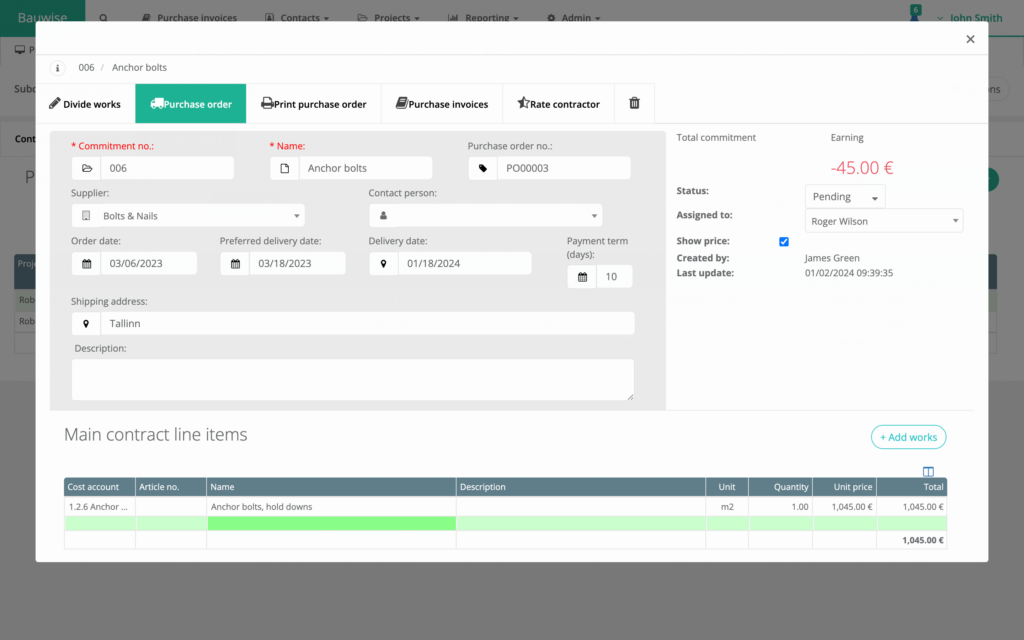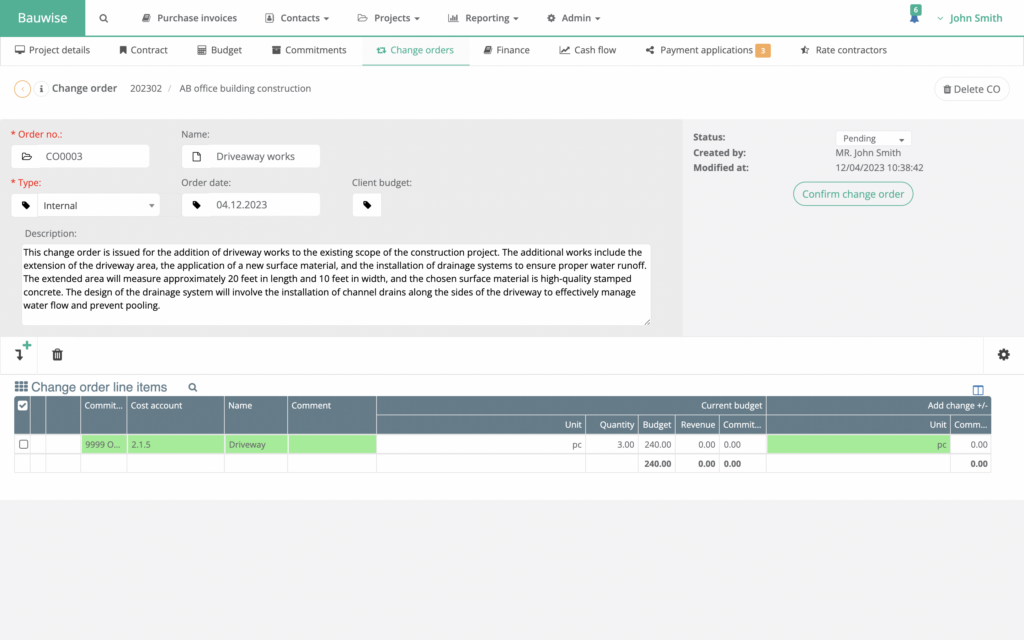In the construction industry, the terms “purchase order” and “change order” refer to two distinct types of documents, each serving a different purpose and function.
A purchase order is a commercial document issued by a buyer, such as a contractor or subcontractor, to a supplier. This document outlines the types, quantities, and agreed-upon prices for products or services. It serves as the first official offer from the buyer to the seller, detailing the specifics of what is being bought, and it becomes a binding contract once accepted by the seller. In construction, purchase orders are crucial for ordering materials, equipment, and sometimes services. They are integral to the project’s initial budgeting and planning phase.

Purchase order key takeaways (PO):
- Definition: A purchase order is a document issued by the buyer (typically the contractor or subcontractor) to a supplier, indicating types, quantities, and agreed prices for products or services. It’s a commercial document and the first official offer issued by a buyer to a seller, indicating types, quantities, and agreed prices for products or services.
- Purpose: The primary purpose of a PO is to initiate a purchase transaction. It outlines the specifics of the goods or services being bought and serves as a legal offer to buy.
- Content: It generally includes item descriptions, quantities, prices, delivery dates, payment terms, and other terms and conditions.
- Process: Once the seller accepts a PO, it becomes a binding contract. It’s a crucial document in the procurement process and for inventory management.
- Role in Construction: In construction, POs are used to order materials, equipment, and, sometimes, services necessary for a project. They are part of the project’s initial budget and planning phase.
On the other hand, a change order is a document used to record modifications to the original construction contract. These modifications can include changes in the project’s scope, such as alterations to design, quantities, specifications, and sometimes the project schedule. The primary purpose of a change order is to document any agreed-upon changes that occur after the signing of the original contract, which may include additional work, deletions, or other alterations. Change orders typically provide a detailed description of the new work, revised quantities, cost changes, and the impact on the project schedule and may include new terms and conditions. For a change order to be effective, it must be agreed upon and signed by all key stakeholders, including the owner, contractor, and often the architect or engineer. In the construction field, change orders are a common occurrence due to the dynamic nature of construction projects, and they are vital for managing changes in the project scope, ensuring all parties agree with these adjustments.

Change order key takeaways:
- Definition: A change order is a document used to record an amendment to the original construction contract. It outlines changes in the scope of work, including alterations to the design, quantities, specifications, and sometimes the project schedule.
- Purpose: The primary purpose of a change order is to document any agreed-upon changes that occur after the original contract has been signed. This can include additional work, deletions, or other modifications.
- Content: It typically includes a detailed description of the new work, revised quantities, changes in costs, and the impact on the project schedule. It may also have new terms and conditions.
- Process: For a change order to be effective, it must be agreed upon and signed by all key stakeholders, usually including the owner, contractor, and architect or engineer. It legally modifies the original contract.
- Role in Construction: Change orders are common in construction due to the dynamic nature of projects. They are essential for managing alterations in the project scope and ensuring that all parties are aware of and agree to these changes.
Real-life examples of purchase and change orders in construction
Imagine a construction company working on a new office building. For purchasing materials, they issue a purchase order to a supplier for 10,000 bricks, 500 bags of cement, and 300 steel beams, specifying the types, sizes, and agreed prices for these materials. This purchase order would detail the quantities, delivery date, total cost, and payment terms. It is a formal agreement for the supplier to deliver these materials at the specified costs and conditions.
In the same construction project, suppose the client decides to add a new feature, like a glass façade, instead of the initially planned brick wall. This change would necessitate a change order. The change order would describe the modification in the project scope, detailing the removal of the brick wall from the plan and the addition of the glass façade. It would list the new materials needed, the extra costs involved, and the impact on the project timeline. The change order would require approval and signatures from the construction company, the client, and possibly the architect or engineer to validate the agreement on this significant alteration to the original plan.
These examples closely resemble what you would find in real-life construction projects. They illustrate how purchase orders and change orders are routinely used to manage procurement and changes in construction projects, ensuring clarity and agreement among all parties involved.
Written by

Taavi Kaiv
Taavi Kaiv is a construction specialist with over ten years of experience in the construction industry. Taavi is an accomplished construction project manager with many successful projects that have been completed under his guidance. Taavi holds a master’s degree in construction management from the Tallinn University of Technology. View profile
Streamline your change orders with Bauwise change order management software
Bauwise offers a user-friendly change order software that simplifies the tracking, processing, and approval of change orders. With its intuitive interface, you can easily create, modify, and manage change orders, ensuring that all modifications are accurately documented and efficiently processed. The software provides real-time updates and alerts, keeping all stakeholders informed and aligned, thus reducing delays and misunderstandings. Try Bauwise for free today!
Related content
Read our other articles where you can find helpful and relevant information about construction change orders:




